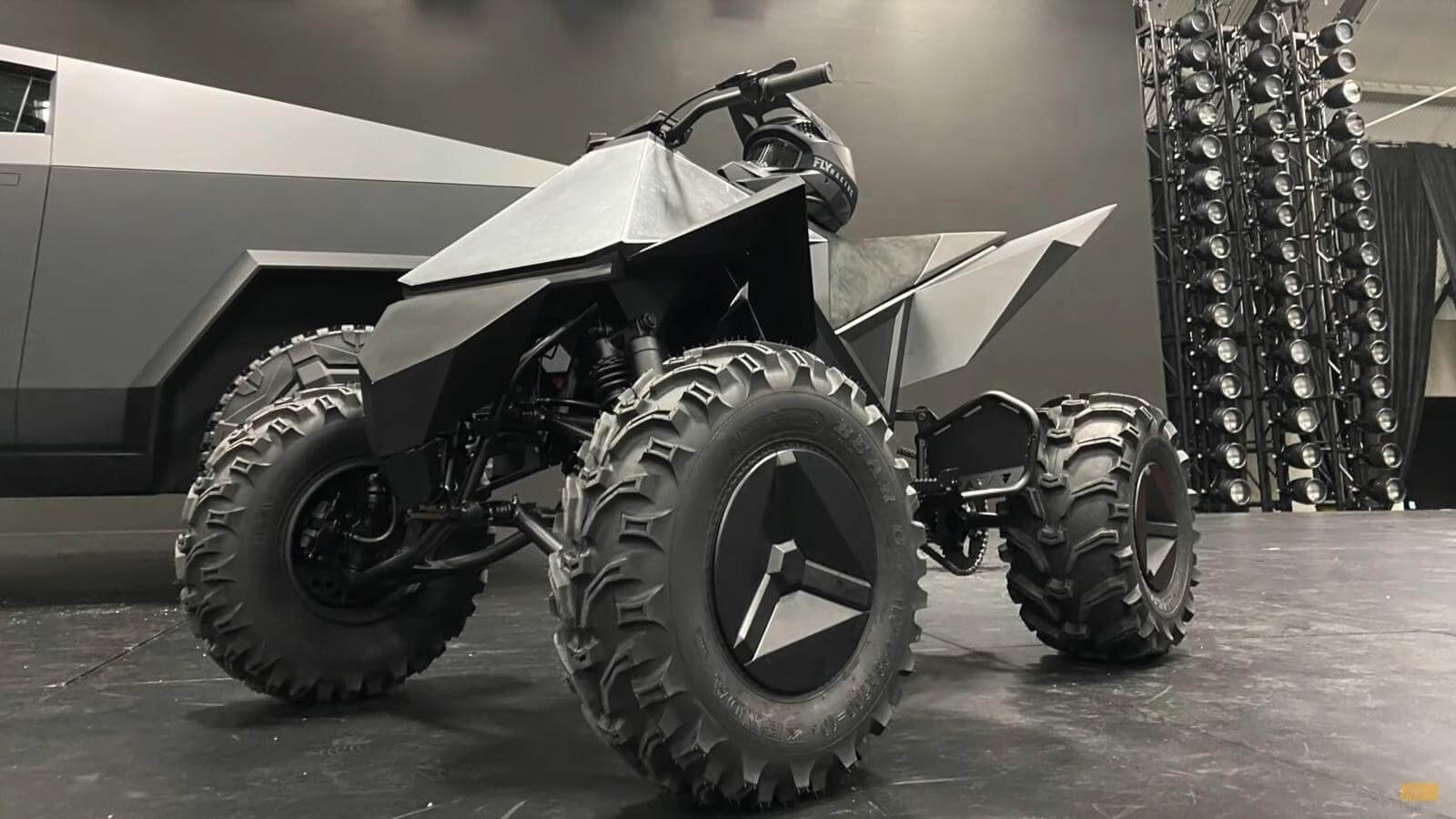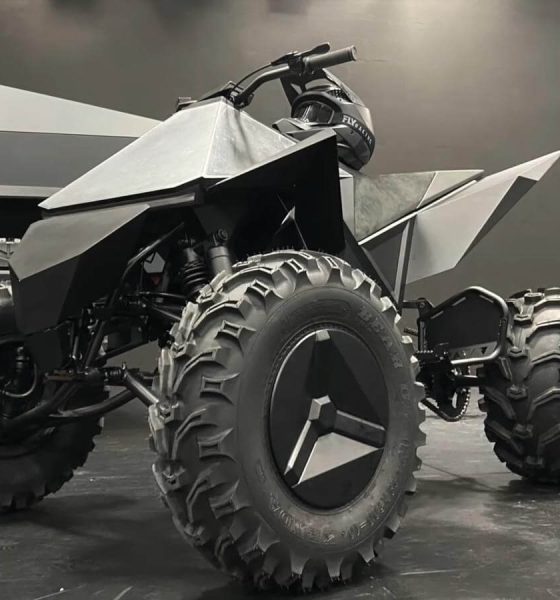

News
Tesla’s Elon Musk reveals release date for ATV, hints at electric dirt bike
Tesla CEO Elon Musk has confirmed that the all-terrain vehicle (ATV) the company unveiled in the Cybertruck event will be released around the same time as the all-electric pickup. The Cybertruck’s Dual-Motor and Tri-Motor variants will begin production in late 2021, with the Single Motor RWD trim starting in late 2022.
Musk made the announcement following a question from the Tesla Owners Silicon Valley’s Twitter account, which asked if there were any updates on the ATV. Details about the ATV were slim following the unveiling, as Musk announced the four-wheeler at the tail end of the Cybertruck unveiling event. Musk did mention that the ATV will be a two-seater, and it will complement the Cybertruck as it charges directly in the pickup’s “Vault.” An electric dirt bike was also mentioned.
“We’ll aim to have it come out same time as truck. Two-seater electric ATV designed to work with Cybertruck will be fun! Electric dirt bikes would be cool too. We won’t do road bikes, as too dangerous. I was hit by a truck & almost died on one when I was 17,” Musk said on Twitter.
We’ll aim to have it come out same time as truck. Two seater electric ATV designed to work with Cybertruck will be fun! Electric dirt bikes would be cool too. We won’t do road bikes, as too dangerous. I was hit by a truck & almost died on one when I was 17.
— Elon Musk (@elonmusk) December 8, 2019
Musk also addressed the idea that the company could produce a street-legal motorcycle in the future. While some Tesla enthusiasts have been asking for the Silicon Valley-based electric car maker to produce a motorcycle that could be used on the street, Musk shot down the idea with a story from his teenage years where he was hit by a truck while riding one. Musk has told this story in the past, specifically at the 2018 Tesla Shareholder’s Meeting, when he stated that an accident with a motorbike nearly ended his life. “We’re not going to do motorcycles,” Musk stated.
Those interested in the ATV are still waiting for Tesla and Musk to release the finer details of the vehicle, like weight, range, and whether it will be available in different variants like the company’s cars. Those who have pre-ordered the Cybertruck will have the ATV available as an option, according to a previous tweet from the Tesla CEO.
Tesla’s unveiling of the Cybertruck, along with its development of an ATV and now a possible dirt bike, is evidence the company is starting to embracing the outdoor market. The Cybertruck, while not aimed directly toward off-roading, camping, and outdoor activities like the Rivian R1T pickup and R1S sport utility vehicle, offer enough towing capacity to haul a fully-loaded camper or RV. Musk’s interest in four-wheelers and dirt bikes could help Tesla reach out to a completely new customer base as well, just as the Cybertruck attracts a potential new market.
The Tesla Cybertruck’s full capabilities were not really discussed much during its unveiling event, as Musk appeared to have expedited the vehicle’s presentation following its failed Armor Glass demonstration. Yet, despite this, there is very little doubt that the Cybertruck will be a tough-as-nails pickup, as evidenced by its stainless steel exoskeleton and its potential off-roading capability that is teased by its 16″ ride height. Auto veteran Jack Rickard mentioned this in a segment in his YouTube channel.
“This thing’s a Hummer. A Ford F-150, the tricked out 4×4 Supercrew cab, has 9.6” of ground clearance. This has 16” – that’s like a Hummer. I think the Hummer H1 was 16. So it makes a big difference in off-roading And underneath that, I’m told it’s all armored, it’s all covered, you can’t get at the motors, you can’t get at the batteries, it’s a skidplate. So specifically, on the things that define a pickup truck, and I’m surprised Elon Musk even knew what those were, but he’s got it, and that’s this offroad capability, and this kind of tough, durable, manly kind of gig,” Rickard said.

Elon Musk
Elon Musk and Tesla AI Director share insights after empty driver seat Robotaxi rides
The executives’ unoccupied tests hint at the rapid progress of Tesla’s unsupervised Robotaxi efforts.

Tesla CEO Elon Musk and AI Director Ashok Elluswamy celebrated Christmas Eve by sharing personal experiences with Robotaxi vehicles that had no safety monitor or occupant in the driver’s seat. Musk described the system’s “perfect driving” around Austin, while Elluswamy posted video from the back seat, calling it “an amazing experience.”
The executives’ unoccupied tests hint at the rapid progress of Tesla’s unsupervised Robotaxi efforts.
Elon and Ashok’s firsthand Robotaxi insights
Prior to Musk and the Tesla AI Director’s posts, sightings of unmanned Teslas navigating public roads were widely shared on social media. One such vehicle was spotted in Austin, Texas, which Elon Musk acknowleged by stating that “Testing is underway with no occupants in the car.”
Based on his Christmas Eve post, Musk seemed to have tested an unmanned Tesla himself. “A Tesla with no safety monitor in the car and me sitting in the passenger seat took me all around Austin on Sunday with perfect driving,” Musk wrote in his post.
Elluswamy responded with a 2-minute video showing himself in the rear of an unmanned Tesla. The video featured the vehicle’s empty front seats, as well as its smooth handling through real-world traffic. He captioned his video with the words, “It’s an amazing experience!”
Towards Unsupervised operations
During an xAI Hackathon earlier this month, Elon Musk mentioned that Tesla owed be removing Safety Monitors from its Robotaxis in Austin in just three weeks. “Unsupervised is pretty much solved at this point. So there will be Tesla Robotaxis operating in Austin with no one in them. Not even anyone in the passenger seat in about three weeks,” he said. Musk echoed similar estimates at the 2025 Annual Shareholder Meeting and the Q3 2025 earnings call.
Considering the insights that were posted Musk and Elluswamy, it does appear that Tesla is working hard towards operating its Robotaxis with no safety monitors. This is quite impressive considering that the service was launched just earlier this year.
Elon Musk
Starlink passes 9 million active customers just weeks after hitting 8 million
The milestone highlights the accelerating growth of Starlink, which has now been adding over 20,000 new users per day.

SpaceX’s Starlink satellite internet service has continued its rapid global expansion, surpassing 9 million active customers just weeks after crossing the 8 million mark.
The milestone highlights the accelerating growth of Starlink, which has now been adding over 20,000 new users per day.
9 million customers
In a post on X, SpaceX stated that Starlink now serves over 9 million active users across 155 countries, territories, and markets. The company reached 8 million customers in early November, meaning it added roughly 1 million subscribers in under seven weeks, or about 21,275 new users on average per day.
“Starlink is connecting more than 9M active customers with high-speed internet across 155 countries, territories, and many other markets,” Starlink wrote in a post on its official X account. SpaceX President Gwynne Shotwell also celebrated the milestone on X. “A huge thank you to all of our customers and congrats to the Starlink team for such an incredible product,” she wrote.
That growth rate reflects both rising demand for broadband in underserved regions and Starlink’s expanding satellite constellation, which now includes more than 9,000 low-Earth-orbit satellites designed to deliver high-speed, low-latency internet worldwide.
Starlink’s momentum
Starlink’s momentum has been building up. SpaceX reported 4.6 million Starlink customers in December 2024, followed by 7 million by August 2025, and 8 million customers in November. Independent data also suggests Starlink usage is rising sharply, with Cloudflare reporting that global web traffic from Starlink users more than doubled in 2025, as noted in an Insider report.
Starlink’s momentum is increasingly tied to SpaceX’s broader financial outlook. Elon Musk has said the satellite network is “by far” the company’s largest revenue driver, and reports suggest SpaceX may be positioning itself for an initial public offering as soon as next year, with valuations estimated as high as $1.5 trillion. Musk has also suggested in the past that Starlink could have its own IPO in the future.
News
NVIDIA Director of Robotics: Tesla FSD v14 is the first AI to pass the “Physical Turing Test”
After testing FSD v14, Fan stated that his experience with FSD felt magical at first, but it soon started to feel like a routine.

NVIDIA Director of Robotics Jim Fan has praised Tesla’s Full Self-Driving (Supervised) v14 as the first AI to pass what he described as a “Physical Turing Test.”
After testing FSD v14, Fan stated that his experience with FSD felt magical at first, but it soon started to feel like a routine. And just like smartphones today, removing it now would “actively hurt.”
Jim Fan’s hands-on FSD v14 impressions
Fan, a leading researcher in embodied AI who is currently solving Physical AI at NVIDIA and spearheading the company’s Project GR00T initiative, noted that he actually was late to the Tesla game. He was, however, one of the first to try out FSD v14.
“I was very late to own a Tesla but among the earliest to try out FSD v14. It’s perhaps the first time I experience an AI that passes the Physical Turing Test: after a long day at work, you press a button, lay back, and couldn’t tell if a neural net or a human drove you home,” Fan wrote in a post on X.
Fan added: “Despite knowing exactly how robot learning works, I still find it magical watching the steering wheel turn by itself. First it feels surreal, next it becomes routine. Then, like the smartphone, taking it away actively hurts. This is how humanity gets rewired and glued to god-like technologies.”
The Physical Turing Test
The original Turing Test was conceived by Alan Turing in 1950, and it was aimed at determining if a machine could exhibit behavior that is equivalent to or indistinguishable from a human. By focusing on text-based conversations, the original Turing Test set a high bar for natural language processing and machine learning.
This test has been passed by today’s large language models. However, the capability to converse in a humanlike manner is a completely different challenge from performing real-world problem-solving or physical interactions. Thus, Fan introduced the Physical Turing Test, which challenges AI systems to demonstrate intelligence through physical actions.
Based on Fan’s comments, Tesla has demonstrated these intelligent physical actions with FSD v14. Elon Musk agreed with the NVIDIA executive, stating in a post on X that with FSD v14, “you can sense the sentience maturing.” Musk also praised Tesla AI, calling it the best “real-world AI” today.








